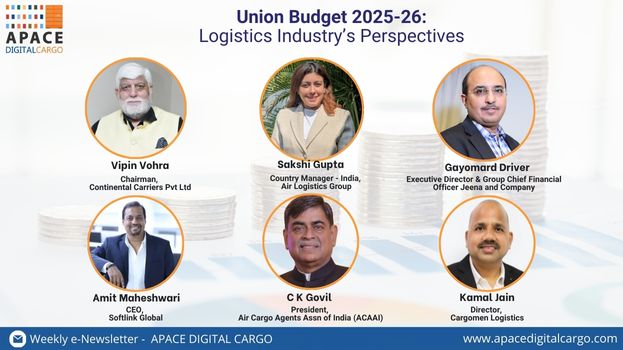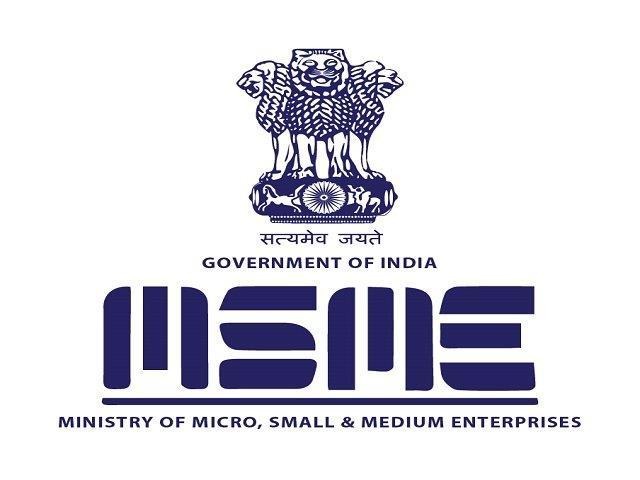
On February 1, 2025, Finance Minister Nirmala Sitharaman presented the Union Budget for 2025-26 in the Lok Sabha, highlighting significant developments for the logistics and cargo sector.
The budget prioritizes the strengthening of the Micro, Small, and Medium Enterprises (MSME) sector, the enhancement of maritime and air cargo infrastructure, and the facilitation of seamless trade through private sector integration. Additionally, the government has introduced tax incentives for businesses that invest in environmentally sustainable logistics solutions, underscoring its commitment to sustainability. These initiatives are expected to reduce costs and improve the overall competitiveness of the industry, thereby promoting stronger trade and commerce.
It is essential to assess the industry’s sentiment regarding the budget’s impact. Apace Digital Cargo has gathered their perspectives –
Vipin Vohra, Chairman, Continental Carriers Pvt Ltd.
The Union Budget 2025-26 charts an ambitious course for growth while emphasizing fiscal responsibility. In particular, the logistics, air cargo, and supply chain sectors receive targeted support through measures designed to boost operational efficiency, optimize costs, and accelerate technological transformation.
Air Cargo Infrastructure: Increased capital allocation for air cargo infrastructure in emerging industrial regions to enhance seamless connectivity with global trade routes.
Infrastructure & Warehousing: Upgradation of air cargo facilities, including high-value perishable produce, with streamlined cargo screening and customs Protocols.
Skill Development: Establishment of five National Centres of Excellence with global expertise to equip youth for “Make for India, Make for the World” Initiatives.
Manufacturing & Global Supply Chains: Support for domestic manufacturing capacities with sector-specific facilitation groups, including industry and government representation.
Digital Trade Platform: Launch of BharatTradeNet (BTN)—a unified platform for trade documentation and financing, complementing the Unified Logistics Interface Platform (ULIP).
Maritime Development Fund: ₹25,000 crore allocated to boost competition and growth in global ocean trade.
Regional Connectivity Expansion: A revamped UDAN scheme to connect 120 new destinations, operationalize more helipads and smaller airports, and facilitate 4 crore passengers in the next decade.
Through effective partnership between government and industry stakeholders, coupled with robust implementation of these budgetary measures, India’s air cargo and logistics landscape stands poised for transformative growth.
Sakshi Gupta, Country Manager – India, Air Logistics Group
The Budget 2025 sets the pace and thrust for Bharat’s manufacturing & logistic expansion, which in turn should have a multiplier effect on the economy.
The government’s comprehensive approach in the budget is set to transform the logistics landscape, making it more resilient, efficient, and adaptable to future challenges. This proactive stance is anticipated to yield substantial benefits for businesses and the economy at large, fostering growth and development.
The budget places a spotlight on fortifying the MSME sector, elevating air cargo infrastructure, and facilitating seamless trade through the harmonious integration of private sector engagement. A modernized logistics framework will not only expedite the movement of shipments but also lower costs for exporters, thereby enhancing the competitiveness of Indian goods in international markets. The government’s focus on multimodal logistics—integrating road, rail, air, and waterways—further underscores India’s potential as a prominent trade hub.
The enhancement of air cargo facilities, coupled with increased private sector participation, is destined to elevate efficiency and capacity in the handling of goods. This initiative aligns with the vision of crafting a modern and adaptable logistics network that can satisfy the dynamic demands of the economy.
Moreover, the focus on PM Gati Shakti and digital infrastructure underscores the vital role of connectivity in fostering economic prosperity. By harnessing the power of technology, the government seeks to refine operations and forge swifter, more efficient trade routes.
While the roadmap is sketched & ‘GO INDIA GO’ is the voice , still
execution will be key—
the needle must move ⏰
After all, funds on paper must translate into swifter implementation for tangible economic impact.
Amit Maheshwari, CEO, Softlink Global
The Finance Bill 2025 makes some progress in streamlining customs processes and tax compliance for logistics, but it also increases the regulatory burden on freight forwarders. Faster dispute resolution and improved customs duty assessments will help reduce clearance delays, but enhanced powers for reassessments could lead to unexpected cost escalations. A key missed opportunity in this bill is the lack of incentives for AI and automation in logistics.
While global markets are actively investing in AI-driven supply chain optimization, India’s logistics sector is left without structured tax benefits for AI-powered automation, paperless trade, and blockchain security solutions. If we want to position India as a global logistics leader, we need policies that encourage digital transformation and next-gen logistics technology. We hope to see these gaps addressed in future reforms.
Gayomard Driver – Executive Director & Group Chief Financial Officer Jeena and Company
The Union Budget 2025-26 reaffirms the government’s commitment to infrastructure development, taking it to new heights. We welcome this focus, particularly on strengthening logistics through enhanced infrastructure, digital transformation, and supportive policies, which will be a game changer for India’s supply chain ecosystem.
The introduction of the Bharat Trade Net Platform for seamless trade documentation and financing, along with the ₹25,000 crore Maritime Development Fund, are strategic moves that will drive efficiency, and boost global competitiveness. The Maritime Development Fund will not only enhance India’s logistics and trade capabilities but also provide employment opportunities across diverse skill levels—from blue-collar workers to high-tech professionals—ensuring inclusive growth in the maritime economy.
Additionally, the push for modernizing air cargo, investing in geospatial infrastructure, fostering AI-driven innovation, and promoting public-private partnerships will further enhance connectivity and operational agility.
These transformative initiatives position India on the path to becoming a global logistics powerhouse.
C K Govil, President, Air Cargo Agents Association of India (ACAAI)
The Union Budget 2025 introduces several initiatives poised to significantly impact India’s logistics industry:
Infrastructure Development: The budget emphasizes infrastructure enhancements to bolster industrial and logistics growth. Key upgrades include:
- Geospatial Land Records: Improving land record systems to facilitate better planning and investment.
- Air Cargo Facilities: Enhancing air cargo infrastructure to streamline the movement of goods.
- Bharat Trade Net Platform: Implementing a platform to streamline trade documents, reducing administrative burdens.
These initiatives aim to reduce logistics costs and boost domestic manufacturing. Officials predict increased demand for Grade A industrial leasing and warehouses in major markets, driven by PM Gati Shakti’s digital infrastructure.
Support for Manufacturing and MSMEs: The budget outlines measures to strengthen MSME manufacturing, which is expected to fuel urban consumption and promote seamless trade. 
Maritime Infrastructure: There is a focus on building maritime infrastructure to enhance trade competitiveness.
Overall, the budget’s focus on infrastructure development, support for manufacturing, and emphasis on digital and sustainable practices is expected to provide a significant boost to India’s logistics sector.
Kamal Jain, Director, Cargomen Logistics
The Union Budget 2025 is a well-planned strategy to improve infrastructure, logistics, skills, and technology to boost India’s economy. The government is investing a record amount in building roads, railways, and airports, supporting clean energy, and using AI in education. These efforts will create jobs, encourage innovation, and make India more competitive globally. This budget is a positive step towards sustainable growth.
Infrastructure and Logistics
> Capital Expenditure: The government has set aside ₹11.21 lakh crore (3.1% of GDP) to build and improve roads, highways, airports, railways, and power systems. This will make transportation easier and reduce costs for businesses.
> Maritime Development Fund: A special fund of ₹2.5 lakh crore ($3 billion) will be created to help the shipbuilding and repair industry. The government will cover 49% of this amount, while the rest will come from private investors and ports. There will also be a 10-year tax exemption on materials used for shipbuilding and shipbreaking.
> Regional Connectivity (UDAN Scheme): A new UDAN scheme will improve air travel in smaller towns and remote areas. 120 new destinations will be added, making air travel easier for 4 crore passengers in the next 10 years. This scheme will also support helipads and small airports in hilly and underdeveloped regions.
Skilling and Technology
> National Manufacturing Mission: The government is launching a National Manufacturing Mission to support the production of clean technology products like solar panels, electric vehicle batteries, wind turbines, and energy storage systems. This will help India produce more advanced technology domestically.
> Research and Development: ₹20,000 crore has been allocated to encourage private companies to invest in research, innovation, and new technologies. Also, 10,000 Prime Minister Research Fellowships will be given to students in top institutes like IITs and IISc to promote cutting-edge research.
> Artificial Intelligence in Education: A Centre of Excellence for AI in Education will be set up with ₹500 crore. This center will use AI tools to improve learning and make education more effective.
This budget focuses on developing infrastructure, modernizing technology, and creating job opportunities. It aims to strengthen India’s economy and improve the lives of its people.





